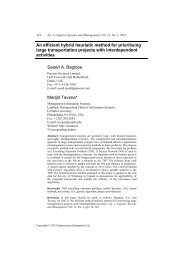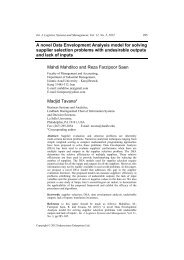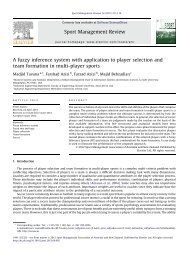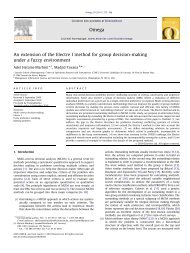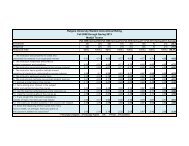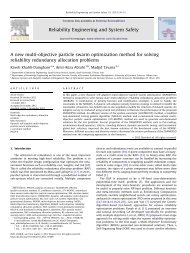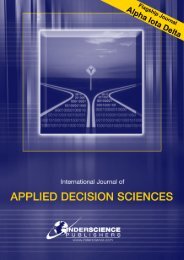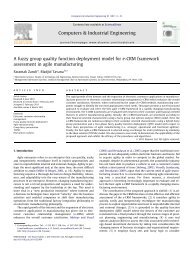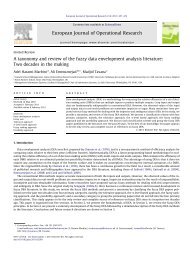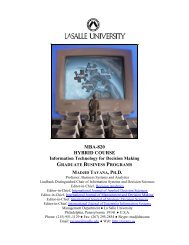A Fuzzy Multidimensional Multiple-Choice Knapsack - Dr. Madjid ...
A Fuzzy Multidimensional Multiple-Choice Knapsack - Dr. Madjid ...
A Fuzzy Multidimensional Multiple-Choice Knapsack - Dr. Madjid ...
You also want an ePaper? Increase the reach of your titles
YUMPU automatically turns print PDFs into web optimized ePapers that Google loves.
Ann Oper Res (2013) 206:449–483 451fuzzy multi-dimensional multiple-choice knapsack problems. They compared the performanceof the two methods statistically with respect to a set of simulated benchmark casesusing different diversity and accuracy metrics.In this paper, the knapsack formulation, an Efficient Epsilon-Constraint (EEC) method,and a customized multi-objective evolutionary algorithm are integrated into a structuredbut yet flexible model for solving the project selection problems in fuzzy environments.The proposed integrated model is not subject to the abovementioned drawbacks of DEAand the knapsack formulation, and also selects a portfolio of projects with fuzzy input andoutput data with respect to organizational objectives and resource constraints. Moreover, thecurrent MMKPs in the literature are formulated to fill the knapsacks by picking exactly oneitem from each group. However, this assumption may be difficult to quantify in real worldproblems where the membership of an item to a group is not precise. In the proposed modelwe represent the membership function with fuzzy numbers rather than precise numbers.The remainder of the paper is organized as follows: A review of the relevant literatureon knapsack problems and DEA models is presented in Sect. 2. The details of the proposedframework including the problem definition, the solution procedures, and the pruningmethod are presented in Sect. 3. A real-world case study is presented in Sect. 4 to demonstratethe applicability of the proposed framework and exhibit the efficacy of the proceduresand algorithms. The results of the experiment are presented in Sect. 5. Finally, we end thepaper with conclusions and future research directions in Sect. 6.2 Literature reviewA multi-objective decision making model is composed of a vector of decision variables,objective functions, and constraints. The Decision Makers (DMs) are expected to considerthe available resources and constraints while optimizing multiple objective functions. Letus consider the following definitions for multi-objective decision making problems (Hwangand Masud 1979):Definition 1.1 x ∗ is said to be a complete optimal solution, if and only if there exists x ∗ ∈X such that f i (x ∗ ) ≤ f i (x), i = 1,...,k,forallx ∈ X. Also, the ideal solution, superiorsolution, orutopia point are equivalent terms indicating a complete optimal solution. Ingeneral, such a complete optimal solution that simultaneously minimizes all of the objectivefunctions does not always exist when the objective functions conflict with each other.Definition 1.2 x ∗ is said to be a Pareto optimal solution, if and only if there does not existanother x ∈ X such that f i (x) ≤ f i (x ∗ ) for all i and f j (x) < f j (x ∗ ) for at least one j. ThePareto optimal solution is also named differently by different disciplines: non-dominatedsolution, non-inferior solution, efficient solution, andnon-dominate solution.Definition 1.3 x ∗ is said to be a weak Pareto optimal solution, if and only if there does notexist another x ∈ X such that f i (x) ≤ f i (x ∗ ), i = 1,...,k.Let X CO , X P ,andX WP denote complete optimal, Pareto optimal, and weak Pareto optimalsolution sets, respectively. We can easily obtain X CO ⊆ X P ⊆ X WP from the abovedefinitions.Multi-objective decision making problems often do not have a unique solution and thereforethe DMs are required to choose a solution from the set of efficient solutions (Hwang



